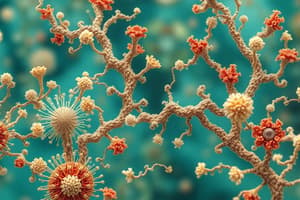Podcast
Questions and Answers
A researcher observes that a certain plant species grows taller in sunny areas compared to shady areas. Which of the following is the most appropriate null hypothesis for this observation?
A researcher observes that a certain plant species grows taller in sunny areas compared to shady areas. Which of the following is the most appropriate null hypothesis for this observation?
- Sunlight directly causes increased plant height in this species.
- There is no relationship between the amount of sunlight and the height of this plant species. (correct)
- Increased plant height causes greater exposure to sunlight.
- The plant species will only grow in sunny areas.
Consider three different ecosystems: a rainforest, a temperate forest, and a desert. Which of the following provides the most comprehensive measure of biodiversity across these ecosystems?
Consider three different ecosystems: a rainforest, a temperate forest, and a desert. Which of the following provides the most comprehensive measure of biodiversity across these ecosystems?
- Determining the variety of species and their relative abundance in each ecosystem. (correct)
- Counting the total number of individual organisms in each ecosystem.
- Estimating the total biomass (total mass of organisms) in each ecosystem.
- Measuring the physical size and geographic area of each ecosystem.
A population of frogs in a remote mountain lake has been declining rapidly over the past decade. Scientists have identified several contributing factors, including habitat loss due to increased logging activity, the introduction of a non-native fish species that preys on tadpoles, and a fungal disease that is affecting the adult frogs. Which of the following conservation strategies would most effectively address the combined impact of these threats and improve the long-term survival of the frog population?
A population of frogs in a remote mountain lake has been declining rapidly over the past decade. Scientists have identified several contributing factors, including habitat loss due to increased logging activity, the introduction of a non-native fish species that preys on tadpoles, and a fungal disease that is affecting the adult frogs. Which of the following conservation strategies would most effectively address the combined impact of these threats and improve the long-term survival of the frog population?
- Focusing solely on captive breeding and reintroduction programs, while ignoring the underlying environmental issues.
- Conducting further research to precisely quantify the relative impact of each threat, before taking any action.
- Implementing strict regulations to limit logging activities, controlling the population of the non-native fish, and developing a treatment for the fungal disease. (correct)
- Moving the remaining frogs to a different, seemingly more suitable habitat.
Which process results in two daughter cells, each with the same number of chromosomes as the parent cell?
Which process results in two daughter cells, each with the same number of chromosomes as the parent cell?
During meiosis, at which stage do homologous chromosomes separate?
During meiosis, at which stage do homologous chromosomes separate?
A cell with a diploid number of 24 undergoes meiosis. How many chromosomes will each daughter cell have after meiosis II?
A cell with a diploid number of 24 undergoes meiosis. How many chromosomes will each daughter cell have after meiosis II?
Which of the following statements accurately describes a key difference between oogenesis and spermatogenesis?
Which of the following statements accurately describes a key difference between oogenesis and spermatogenesis?
Which of the following best describes the concept of particulate inheritance?
Which of the following best describes the concept of particulate inheritance?
Flashcards
Scientific Method
Scientific Method
A systematic process for investigating phenomena, acquiring new knowledge, or correcting previous knowledge.
Hypothesis
Hypothesis
A testable prediction about the relationship between variables.
Biodiversity
Biodiversity
The variety of life in the world or a particular habitat or ecosystem, measured by species richness and abundance.
Extinction
Extinction
Signup and view all the flashcards
Weather vs Climate
Weather vs Climate
Signup and view all the flashcards
Meiosis
Meiosis
Signup and view all the flashcards
Alleles
Alleles
Signup and view all the flashcards
Mendel's Model Organism
Mendel's Model Organism
Signup and view all the flashcards
Study Notes
Topic 1: Science and the Scientific Method
- Science is a process, not a body of facts.
- The scientific method involves defining a problem, forming a hypothesis, testing it, and analyzing the results.
- A good hypothesis is testable and falsifiable, often using a "null" hypothesis which assumes no effect.
- Living things share characteristics including organization, metabolism, growth, reproduction, responsiveness and adaptation.
- The theory of spontaneous generation (abiogenesis) was disproven by experiments of Needham, Spallanzani, and Pasteur, who supported the cell theory (biogenesis).
Topic 2: Biodiversity, Extinction, and Climate Change
- Data is information collected and used to draw conclusions about phenomena.
- Data can be represented in tables, graphs, and charts, and independent and dependent variables are essential to analyze data relationships.
- Biodiversity is the variety of species in a region, and its measures include species richness and species diversity.
- Extinction is the death of all members of a species.
- Extinction rates have increased significantly since the 1800s.
- Threats to biodiversity include habitat loss, pollution, and climate change.
- Weather refers to short-term atmospheric conditions, while climate is long-term weather patterns.
- Climate change is primarily driven by human activity, such as increased carbon dioxide emissions, leading to warming and its consequences.
Topic 3: Cell Division and Reproduction
- Asexual reproduction creates offspring genetically identical to the parent.
- Sexual reproduction involves the fusion of gametes, resulting in diverse offspring.
- Mitosis and meiosis are essential processes for cellular division.
- Somatic cells are body cells, while autosomes are non-sex chromosomes; sex chromosomes determine sex.
- Chromosomes are composed of DNA and proteins.
- Terminology including ploidy levels (haploid, diploid, polyploid), homologous and non-homologous, sister and non-sister chromosomes are important.
- Meiosis I and meiosis II differ in how chromosomes separate causing variation.
- Gametogenesis (oogenesis and spermatogenesis) create gametes for sexual reproduction.
Topic 4: Inheritance Patterns
- Hypotheses of inheritance include blending inheritance, acquired characteristics, and particulate inheritance.
- Mendel’s work with pea plants was crucial to understanding inheritance patterns.
- Model organisms are useful for studying biological processes.
- Key terms include trait, parental (P1), first filial (F1) generation, genotype, phenotype, dominant genes, recessive genes, homozygous, heterozygous.
- Monohybrid crosses and dihybrid crosses help in understanding phenotypic ratios and determining allele combinations.
- Principles of segregation and independent assortment relate to the distribution of genes during gamete formation.
- Understanding linkage (genes on the same chromosome that tend to be inherited together), sex-linked traits, and crossing over is important.
- Polygenic expression and other variation in traits is also essential.
- Incomplete dominance, pleiotropy, codominance, and epistasis explain additional variations in inheritance.
Studying That Suits You
Use AI to generate personalized quizzes and flashcards to suit your learning preferences.
Related Documents
Description
Explore the scientific method, hypothesis testing, and characteristics of living things. Understand biodiversity, data representation, and the impact of climate change and extinction events on ecosystems and species diversity.





